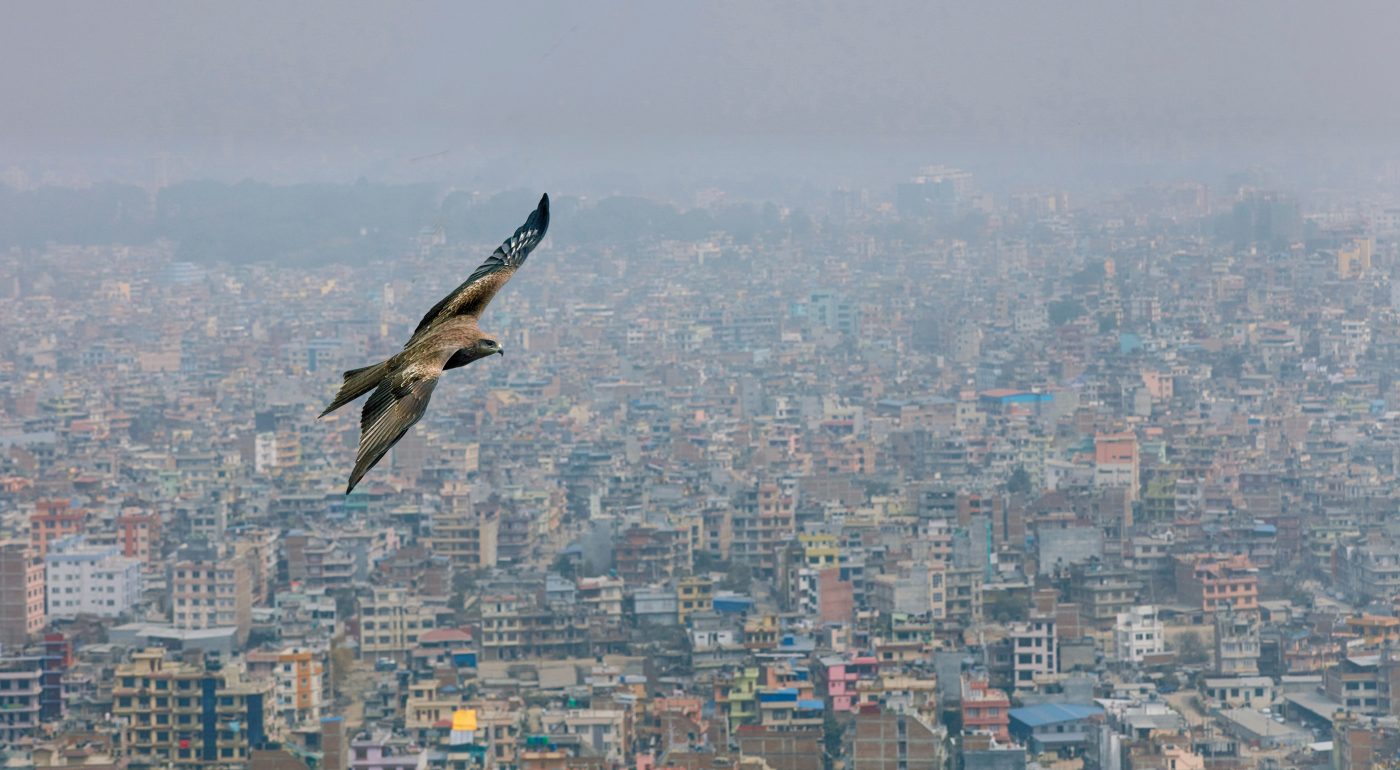What if a crow could take photographs? What kinds of photos would it take? What would the world look like through the eyes of a bird? The title of the fifth Festival of Political Photography is ‘Bird’s-Eye View’. The festival reflects, through photography, on the capacity of humans to imagine the perspective of birds and to understand the world in an alternate way through that lens.

Demelza Kooij, Wolves from above, 2018
The festival also illuminates human blindness to the species loss occurring around us.

Hiwa K, View from above, 2017
Photography and transforming the world into photographs have played a role in our understanding of humans as separate from other animals. The camera lens was originally designed to resemble the structure of the human eye, and the emergence of telephotography, hidden cameras and wildlife cameras has made it possible for humans to intrude on animal communities from afar.

Rorhof, The Pigeon Photographer, 2018, Courtesy of Rorhof / Stadtarchiv Kronberg & Stiftung Deutsches Technikmuseum Berlin
Likewise, the bird’s-eye view, or an elevated view observed from above, was central to the anthropocentric outlook on the future that reigned during the first half of last century. The development of aviation freed humankind from gravity, and skyscrapers raised us above the surface of the Earth to admire its industrial and urban development. This elevation in perspective flattened the world, swept away the horizon and shattered our concept of scale. Bird’s-eye view photography paved the way for a photographic understanding based not on visual likeness but on images whose interpretation required new kinds of skills in visual perception. These ways of using photographs have since become familiar sights in contexts such as map applications and imagery of modern warfare

Tuula Närhinen, Sarjasta Insects among us: Nature Morte, 2019
However, the bird’s-eye view – taking the avian perspective and the animal gaze into account – also enabled a new way to imagine a non-human perspective and gaze. It began to contribute towards a transformation in our notion of anthropocentric depictions of nature. Taking the animal perspective into account served to question the conception created by Western art of the animal as a reflective surface for the human. Earlier, depictions of animals had shown humankind who and what we humans are. The animal was seen as akin to a mirror-like optical attribute. The mirror (animal) did not itself look; it only reflected the gaze of the (human) being looking at it.

Anne Roininen, Puu kaatui, 2021
By using the animal kingdom as its mirror, humanity has come to understand many things about itself, but only by ceasing to use animals as a mirror and by acknowledging their own gaze can we understand even more about the world. Perceiving other species’ viewpoints and ways of life through information and imagination increases the empathy that is vital for the coexistence of humans and other species.

Francesca Todde, A Sensitive Education series, 2020
Through avian eyes, we are also able to examine human blindness to the species loss occurring around us. This creeping yet enormous change is almost invisible. The spectacular murmurations of Starlings are becoming a rare show in the sky. The spring toots of the Boreal Owl are less and less commonly heard in the nocturnal forest. There are hardly any cornfields still featuring the melodic song of the Ortolan Bunting. More than a third of Finnish birds are threatened with extinction. Will birdsong survive only as background music in shopping centre corridors?

Jorma Luhta, Lintumaisema, 2021 / migrans, Kathmandu, Nepal, 2018
If a crow took up photography, could it document species loss or would it take pictures of piles of waste? Could the wise bird use photographs to show us humans how to also look at the world from the viewpoint of species other than our own?
Photographers featured include Camille Auer, Marek Jancovic, Hiwa K, Demelza Kooij, Jorma Luhta, Kristo Muurimaa & Juho Kerola, Tuula Närhinen, Anne Roininen, Rorhof, Leena Saarinen, Francesca Todde and Uhan alla working group.
The festival is produced by The Festival of Political Photography and The Finnish Museum of Photography.
The Finnish Museum of Photography
Large exhibition space
The Cable Factory, Tallberginkatu 1 G, 00180 Helsinki
through January 6, 2022
TAGREE, I love the cultural work you do, I donate to show you my sincere appreciation:
or become a reader with a TAGREEplus+Pass for unlimted access









